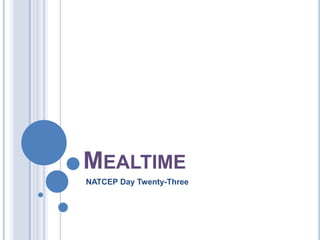
Promoting Positive Mealtimes and Nutrition
- 2. OBJECTIVES Describe measures to promote a positive atmosphere at mealtime. Identify devices & techniques that may be used to help the resident maintain independence. Demonstrate how to feed a resident. Describe and identify dysphagia and actions address. Identify nurse aide actions to eliminate choking risks. Identify choking and demonstrate choking management techniques.
- 3. PROMOTE A POSITIVE MEALTIME ATMOSPHERE Physically comfortable; position, empty bladder, dry clothing. Surroundings should be pleasant and comfortable. Social aspects should be considered – converse with resident, not co-workers! Be positive about mealtime and the experience!
- 4. PROMOTING MEALTIME INDEPENDENCE Food is in a manageable form: cut, buttered, containers opened. Visually impaired: Use numbers of clock to describe location of food. Devices: plate guard or adapted spoon.
- 5. PROPER FEEDING TECHNIQUES Wash hands = both yours and your resident’s Prayer, if requested Sit facing resident Check diet card and items on tray for match Prevent choking: sitting, head of bed elevated Open containers, cut, butter and/or season as preferred Serve food in order of resident preference Offer fluids between bites; alternate Offer to wipe face and hands throughout meal Spoons preferred utensil = 1/3 full Resident should help with finger foods Maintain flavors – don’t combine foods Identify foods as you feed resident “Here is some mashed potatoes” Feed hot foods cautiously Allow adequate time to chew thoroughly Observe, report and record food and fluid intake Notify nurse if they refuse to eat.
- 6. DYSPHAGIA & NURSE AIDE ACTIONS Difficult or painful swallowing Risk for choking Feed slowly, allowing time to chew and swallow. Remind to swallow. Offer fluids frequently. Check for pocketed food or liquid in the cheeks. Place food on strong side of mouth.
- 7. ASPIRATION Fowler’s position. Support upper back, shoulders and neck with a pillow. Observe for signs and symptoms of aspiration when eating or drinking. Check the resident’s mouth for pocketing after eating. Maintain resident in semi-fowler’s position for one hour after eating.
- 8. NUTRITION & FLUID NEEDS NATCEP Day Twenty-Three
- 9. OBJECTIVES Discuss factors that affect nutritional status. Identify modified diets. Describe nurse aide responsibilities for therapeutic diets. Describe the dietary department’s role in providing nutrition to the resident. Identify the importance of hydration. Describe methods to encourage fluid intake. Name nurse aide responsibilities for tube-fed residents. Describe IV therapy and the related nurse aide’s responsibilities.
- 10. FACTORS THAT AFFECT THE NUTRITIONAL STATUS OF THE ELDERLY Tooth loss, poorly fitting dentures, and a sore mouth. Loss of muscle control over part of the mouth and throat as the result of a stroke. Diminished hand and arm muscle strength or control from paralysis or tremor. Diminished sense of smell, taste and vision. Decreased activity resulting in decreased requirement for calories. Serving foods the resident may not like. Mood and behavior problems. Pain and/or discomfort.
- 11. MODIFIED DIETS Low sodium & salt restricted: Heart or kidney disease, fluid retention Diabetic diet: Diabetics Mechanical soft: Dysphagia due to stroke, paralysis, multiple sclerosis Pureed: Dysphagia due to stroke, paralysis, multiple sclerosis
- 12. MODIFIED DIETS Nurse Aide Responsibilities Do not interchange food from one resident’s tray to another Report resident’s request for diet substitutions to the nurse
- 13. MODIFIED DIETS Dietary Department Service Staff Responsibilities Plan meals Diet balanced with adequate nutrients Food prepared and presented in way resident can manage Food presented in way that is visually appealing Infection control maintained Tray cards provided Identify type of diet Identifies resident likes & dislikes Identifies food allergies
- 14. HYDRATION Prevent constipation and urinary incontinence. Dilutes wastes and flushes out urinary system. Maintain skin turgor. Prevent confusion.
- 15. METHODS TO ENCOURAGE FLUID INTAKE Offer water each time you feed a resident Know resident drink preferences Some residents prefer no ice Snacks of juice and fluids may be distributed between meals Offer small amounts of drinks frequently
- 16. TUBE FEEDINGS Enternal Nutrition Giving nutrients into the digestive tract through a feeding tube Person may be unable to ingest, chew or swallow Person may be unable to pass food from the mouth into the esophagus or into the stomach or small intestines Common causes Cancer or trauma to the face, mouth, head or neck Coma Dementia Dysphagia (difficulty swallowing)
- 17. TUBE FEEDINGS
- 18. TUBE FEEDINGS Oral hygiene. Nose and nostril cleaned every 4 hours. Head of bed elevated 30-45 degrees at all times. Oral care for unconscious residents (side-lying position). Care and cleaning of insertion site –wear gloves, soap & water, rinse. Observe for signs and symptoms of infection. Notify nurse if taped tube is loose. Tubes: no pulling, pinching, kinks, twisting. Connections tight and no leaks.
- 19. IV THERAPY Report immediately redness, swelling, pain or tenderness. Tubing: catching, kinking, twisting, pulling. DO NOT TOUCH any clamps or controls on the IV or pump. Assist the resident with personal care and activities with IV in place.